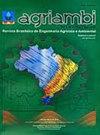基于METRIC和STSEB的能量平衡分析高粱的蒸散量
IF 1.4
4区 农林科学
Q3 AGRICULTURAL ENGINEERING
Revista Brasileira de Engenharia Agricola e Ambiental
Pub Date : 2020-01-01
DOI:10.1590/1807-1929/agriambi.v24n1p24-30
引用次数: 6
摘要
实际地表蒸散量的估算有助于作物需水量的量化。近年来已证明具有很大价值的利用渗湿计来准确估计水需求的另一种办法是利用遥感与基于地表能量平衡的模式相结合的方法。模型种类繁多,可分为两类:一类是单源模型,如采用内化校准(METRIC)算法的高分辨率蒸散发映射(Mapping EvapoTranspiration)模型;另一类是双源模型,如简化双源能量平衡(STSEB)模型。本研究的目的是分析如何使用METRIC和STSEB与蒸渗仪数据进行比较,以估计巴西RN Apodi高粱作物不同发育阶段的ET。两种模型在试验半干旱条件下的日ET估算精度,通过METRIC和STSEB分别具有0.8和0.7 mm d-1的RMSE值,被认为可以接受灌溉管理目的。在瞬时尺度下,METRIC对Rn、LE、H和G的误差分别为60、50、130和5 W m-2,而STSEB对Rn、LE、H和G的误差分别为40、70、120和21 W m-2。在提供高粱需水量信息方面,METRIC模型和STSEB模型非常相似。本文章由计算机程序翻译,如有差异,请以英文原文为准。
Evapotranspiration of sorghum from the energy balance by METRIC and STSEB
The estimate of the actual surface evapotranspiration (ET) contributes to quantifying the water needs of crops. An alternative to the use of lysimeter for an accurate estimation of water needs, which has proved to be of great value in recent years, is the use of remote sensing combined with models based on surface energy balance. There is wide variety of models that can be classified into two types: one-source models, such as the Mapping EvapoTranspiration at high Resolution with Internalized Calibration (METRIC) algorithm, or two-source models, such as the Simplified Two-Source Energy Balance (STSEB). The objective of this study was to analyze how METRIC and STSEB can be used to estimate ET, in comparison with the lysimeter data, for the different stages of development of the sorghum crop in Apodi, RN, Brazil. The accuracy of both models in the daily ET estimation for the semi-arid conditions of the experiment, with RMSE values of 0.8 and of 0.7 mm d-1 through METRIC and STSEB, respectively, is considered acceptable for irrigation management purposes. The errors obtained with METRIC at an instantaneous scale were 60, 50, 130 and 5 W m-2 for Rn, LE, H and G, respectively, on the other hand, using STSEB these errors were of 40, 70, 120 and 21 W m-2 for Rn, LE, H and G, respectively. The METRIC and STSEB models are very similar when it comes to providing information on water needs of the sorghum.
求助全文
通过发布文献求助,成功后即可免费获取论文全文。
去求助
来源期刊

Revista Brasileira de Engenharia Agricola e Ambiental
Agricultural and Biological Sciences-Agronomy and Crop Science
CiteScore
2.70
自引率
16.70%
发文量
114
审稿时长
3-8 weeks
期刊介绍:
A Revista Brasileira de Engenharia Agrícola e Ambiental (Agriambi), periódico oficial da Asociación Latinoamericana y del Caribe de Ingeniería Agrícola (ALIA), é editada mensalmente, no formato eletrônico, pela Unidade Acadêmica de Engenharia Agrícola (UAEA) do Centro de Tecnologia e Recursos Naturais (CTRN) da Universidade Federal de Campina Grande (UFCG), destinando-se à divulgação de artigos científicos originais e inéditos, elaborados em Português, Inglês ou Espanhol. Com o auxílio de pareceres de Consultores, os artigos são aceitos ou não pela Equipe Editorial para publicação na Revista. A Agriambi aceita, também, a submissão de contribuições na modalidade de revisão de literatura.
 求助内容:
求助内容: 应助结果提醒方式:
应助结果提醒方式:


